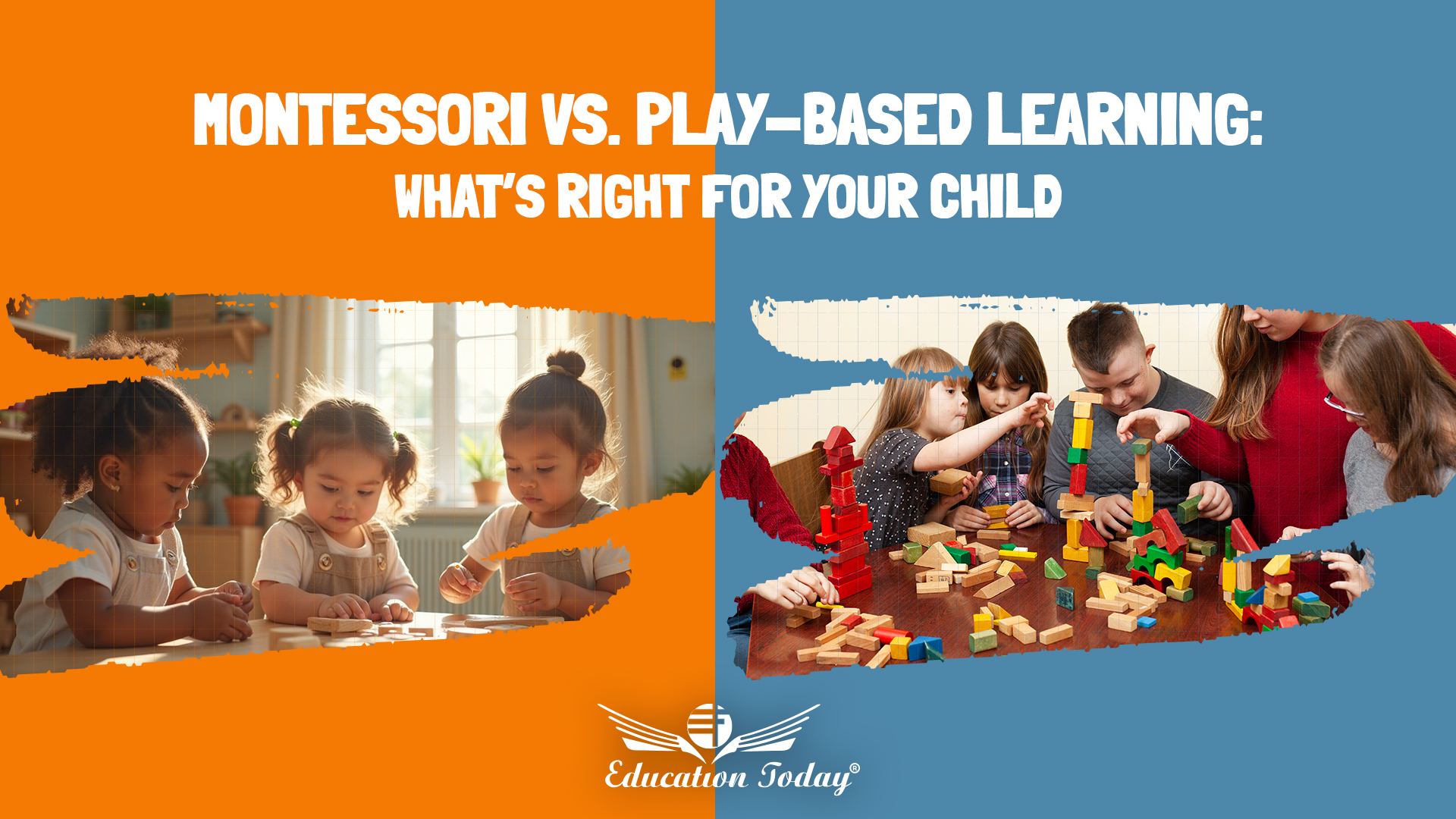Montessori vs. Play-Based Learning: Choosing the Right Approach for Your Child
In today's world of early childhood education, parents aren't just selecting a school — they're choosing a philosophy that will shape how their child experiences the world during the foundational years. A visit to different preschools might reveal quiet, focused children pouring water with intent, or energetic little ones in costume parading through imaginary kingdoms. Behind these activities are two distinct approaches to learning: Montessori and play-based learning.
Both methods are rooted in a deep respect for children as capable and curious beings, but they diverge significantly in how learning happens. Choosing between these approaches can feel overwhelming, but understanding the core principles, benefits, and differences of each can help parents make an informed, confident choice when considering types of preschool programs.
These classrooms are usually multi-age, encouraging mentorship and collaboration between older and younger students. Learning is child-centered but highly purposeful. Children may spend time transferring objects with tongs, arranging beads in specific patterns, or practicing letter sounds using sandpaper letters. These hands-on activities may seem simple, but they are carefully chosen to develop fine motor skills, sequencing, memory, and early academic foundations.
Here, the play-based curriculum for preschool evolves from the child’s interests. A game of grocery store might spark a week-long unit on money and nutrition. Teachers act as facilitators, observing play to identify teachable moments and gently introducing new ideas to extend the learning.
Rather than pitting one method against the other, it’s more helpful to see them as different lenses through which children can explore and grow. Each offers powerful tools for learning, but the key is matching the philosophy to your child’s temperament and your family’s values.
Aarav is methodical. He spends long stretches aligning toy cars by size, loves helping in the kitchen, and thrives in peaceful, predictable routines. His parents often notice how calm and focused he becomes when given a task like folding towels or organizing his books.
For Aarav, a Montessori environment provides the ideal balance of independence and order. The clear structure, real-life tasks, and quiet surroundings support his natural strengths.
Meera, in contrast, is a storyteller. She turns dolls into characters and invents magical adventures involving dragons and moonlight tea parties. She’s expressive, emotionally attuned, and comes alive when playing with others or leading a game.
In a play-based classroom, Meera can follow her creative impulses, collaborate with peers, and develop essential social-emotional skills through shared experiences.
Both Aarav and Meera are learning. Both are growing. But they flourish in settings that honor their individual styles.
Whether your child is quietly tracing sandpaper letters or galloping across the room as a make-believe horse, what matters most is that they feel seen, supported, and empowered to be themselves.
Early childhood education isn't about choosing a side. It’s about following the child — and trusting that, with the right environment, they’ll show you exactly how they learn best.
Both methods are rooted in a deep respect for children as capable and curious beings, but they diverge significantly in how learning happens. Choosing between these approaches can feel overwhelming, but understanding the core principles, benefits, and differences of each can help parents make an informed, confident choice when considering types of preschool programs.
Montessori: Freedom Within Structure
The Montessori method, founded by Dr. Maria Montessori over a century ago, is built around the idea that children are naturally driven to learn when given the right environment. Everything in a Montessori preschool — from the size of the furniture to the layout of learning materials — is intentionally designed to promote independence, focus, and self-discipline.These classrooms are usually multi-age, encouraging mentorship and collaboration between older and younger students. Learning is child-centered but highly purposeful. Children may spend time transferring objects with tongs, arranging beads in specific patterns, or practicing letter sounds using sandpaper letters. These hands-on activities may seem simple, but they are carefully chosen to develop fine motor skills, sequencing, memory, and early academic foundations.
Montessori Preschool Pros and Cons
Strengths of the Montessori Approach:- Fosters independence: Children learn to care for themselves and their environment through daily life skills like buttoning, sweeping, and food preparation.
- Structured yet self-paced: Each child chooses their work but is guided to complete tasks in a logical, focused way.
- Calm and organized learning environment: Ideal for children who are sensitive to overstimulation or thrive in quiet, orderly settings.
- Teachers act as guides: Instead of leading group lessons, educators observe and support children individually based on their interests and readiness.
- Montessori can be too quiet or structured for more extroverted or energetic children who crave dynamic interaction.
- There’s often less emphasis on pretend play, which some parents feel is critical to emotional and social development.
- The Montessori approach may require consistent reinforcement at home, especially in developing independence and limiting screen time or plastic toys.
Play-Based Learning: Learning Through Joyful Exploration
In contrast, play-based learning — sometimes called developmental learning or child-centered learning methods — embraces the idea that play is not a break from learning but the very vehicle through which it occurs. These classrooms are vibrant, bustling spaces filled with dress-up corners, building blocks, water tables, and storytelling areas.Here, the play-based curriculum for preschool evolves from the child’s interests. A game of grocery store might spark a week-long unit on money and nutrition. Teachers act as facilitators, observing play to identify teachable moments and gently introducing new ideas to extend the learning.
Play-Based Learning Benefits
Strengths of Play-Based Learning:- Encourages creativity and imagination: Children create stories, take on roles, and explore different scenarios through dramatic play.
- Builds emotional intelligence: Navigating friendships, resolving conflicts, and expressing feelings are key components of daily learning.
- Great for expressive and social children: Kids who thrive in active, group-oriented settings find natural joy and stimulation.
- Flexible and child-driven: Children explore at their own pace, developing problem-solving skills organically through hands-on experiences.
- The environment can be overwhelming for children who need more structure or struggle with transitions.
- There may be less focus on early academic goals, like letter recognition or fine motor tasks, depending on the program.
- Because it’s “just play” on the surface, some parents may misunderstand the depth of learning occurring without visible output like worksheets.
Comparing Montessori and Play-Based Learning
Though Montessori and play-based approaches appear to be on opposite ends of the spectrum, they share essential values. Both believe that children are capable, curious, and deserving of trust and autonomy. Both prioritize hands-on learning and aim to nurture the whole child — intellectually, emotionally, physically, and socially.Rather than pitting one method against the other, it’s more helpful to see them as different lenses through which children can explore and grow. Each offers powerful tools for learning, but the key is matching the philosophy to your child’s temperament and your family’s values.
Real-Life Example: Aarav and Meera
Consider Aarav and Meera — two bright, curious preschoolers with very different personalities.Aarav is methodical. He spends long stretches aligning toy cars by size, loves helping in the kitchen, and thrives in peaceful, predictable routines. His parents often notice how calm and focused he becomes when given a task like folding towels or organizing his books.
For Aarav, a Montessori environment provides the ideal balance of independence and order. The clear structure, real-life tasks, and quiet surroundings support his natural strengths.
Meera, in contrast, is a storyteller. She turns dolls into characters and invents magical adventures involving dragons and moonlight tea parties. She’s expressive, emotionally attuned, and comes alive when playing with others or leading a game.
In a play-based classroom, Meera can follow her creative impulses, collaborate with peers, and develop essential social-emotional skills through shared experiences.
Both Aarav and Meera are learning. Both are growing. But they flourish in settings that honor their individual styles.
How to Choose the Right Fit
Use these questions to help guide your preschool decision:- Does your child enjoy quiet, focused tasks or social, energetic play?
- Do they thrive in routines or enjoy more flexibility and spontaneity?
- Are you looking for early academic structure or more organic development through play?
- What type of learning environment reflects your parenting values?
Blended Models and Flexibility
Some preschools offer a hybrid early education approach, blending Montessori method principles with developmental learning. These models might feature Montessori-style mornings with practical life and literacy work, followed by play-based afternoons filled with imaginative and outdoor exploration. For families seeking balance, this can be the best preschool teaching method.Let Your Child Lead
Ultimately, the best educational path is one that respects your child’s individuality, supports their development, and aligns with your family’s early education philosophies.Whether your child is quietly tracing sandpaper letters or galloping across the room as a make-believe horse, what matters most is that they feel seen, supported, and empowered to be themselves.
Early childhood education isn't about choosing a side. It’s about following the child — and trusting that, with the right environment, they’ll show you exactly how they learn best.






